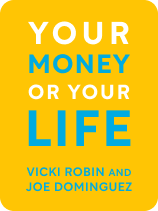

This article is an excerpt from the Shortform book guide to "Your Money or Your Life" by Vicki Robin and Joe Dominguez. Shortform has the world's best summaries and analyses of books you should be reading.
Like this article? Sign up for a free trial here .
Do you feel like you can either have your money or your life? Would you like to break free from that dilemma?
In Your Money or Your Life, Vicki Robin and Joe Dominguez argue that you don’t need to choose; you can have both. They offer nine steps to transform your relationship with money and become financially independent. You don’t have to work for money.
Read on to learn the nine steps outlined in Your Money or Your Life.
The False Choice of “Your Money or Your Life”
We feel like we must choose between our money and our lives, so we spend time at jobs we dislike to earn money that we don’t have enough time or energy to enjoy. In other words, most of us choose money.
But we don’t need to choose; we can have both.
How quickly you reach financial independence depends on your life circumstances, plus the speed and consistency with which you apply these nine steps.
Step 1: Understanding the Flow of Money in Your Life
Your Money or Your Life proposes that, to begin transforming your relationship with money, you need to understand the reasons you choose money, and why they’re harmful.
Problem #1: Choosing Money Over Life Hurts Our Wellbeing
We choose to stay in jobs we don’t like, even when it’s harmful to our wellbeing. The more time we spend working, the less time we have to care for ourselves and our families, be involved in communities, rest, and engage in other pleasures. This causes mental and physical stress, yet we have little to show for this sacrifice. People in the US are working more hours, saving less, and taking on debt.
The two main reasons that we choose work over wellbeing are:
- We don’t know how to leave jobs we don’t like.
- We don’t know how much money is “enough” for our happiness.
Problem #2: Choosing Money Over Life Hurts the Earth
We often consume things we want, but don’t need. When we over-consume, we deplete the planet’s finite resources, robbing future generations.
This modern consumer culture dates back to the early 20th century, when factories could produce more goods than ever before. But though more goods were available, people weren’t buying them because they didn’t need them. Companies needed a way to convince people to buy goods they didn’t need. Thus, the marketing industry was born.
Your Money or Your Life asserts that, to break this habit, we must break from the myths that drive consumer culture:
- Myth #1: Growth is good. We think that spending money will grow the economy, which will alleviate poverty, decrease unemployment, and improve the standard of living for everyone. But we can’t endlessly consume or we’ll deplete the planet of its finite resources.
- Myth #2: Technology will save us. We think the right technology will solve the world’s problems, and feel powerless as individuals to effect real change.
- Myth #3: The danger isn’t so immediate. We don’t feel the urgency to reduce consumption and take action to help the planet because climate change feels like a far-off apocalypse we won’t live to see.
Practice Step 1: Visualize Earnings and Calculate Net Worth
Now that you understand the dangers of choosing money over life, you can start the process of changing your relationship with money and living a life you love. The first step is to examine all the money that you’ve ever earned, and what you have to show for it.
This step has two parts:
- Calculate how much money you’ve earned in your lifetime. Look to sources like income tax returns, Social Security administration statements, and bank accounts.
- Calculate your net worth. Assign a value to each of your possessions worth more than a dollar. Sort them into things you own and things you owe—your assets and liabilities. Subtract your assets from your liabilities to calculate net worth.
Step 2: Tracking Your Money
To understand your relationship with money, you need a definition of money that is consistently true. With this definition, you’ll learn what it means to become financially independent, calculate your real hourly wage, and track your expenses. These are key principles found in Your Money or Your Life.
Money and Financial Independence
People’s definitions of money vary. Some think of it as a material (such as the paper cash is printed on), or a reflection of human psychology—how you spend money reflects your personality. But the one consistently applicable definition is that it’s your life energy: Money represents the time and energy you dedicate to paid work.
With this definition, it’s easier to resist buying things you don’t need—what you buy must be worth the life energy you exerted to pay for it. Do you use and enjoy that jet ski enough to make it worth the life energy you paid for it? In the long-run, you’ll use the definition to transform how you spend both your time and your money to reach financial independence—when you’ve saved and invested enough money that you no longer have to work for pay.
Practice Step 2: Calculate Your Real Hourly Wage and Track Money
Step 2 has two parts:
- Calculate your real hourly wage. Examine the hours you spend working and doing work-related activities—getting ready for work, commuting, shopping for work clothes—per week. This step can help you evaluate whether a job you’re doing is worth the time and money you dedicate to it.
- Track money, down to the penny, that you receive or spend. You’ll use this information to start evaluating and reducing your expenses in Steps 3-6.
Step 3: Creating a Monthly Tabulation
In this step recommended in Your Money or Your Life, you’ll categorize your monthly expenses to capture your unique spending habits. You’ll learn where your money goes and what you have to show for it.
This is different from making a budget. You’re not designating how much to spend in each category and subcategory. Instead, you’ll see what you spend and evaluate if your purchases are worth it.
Practice Step 3: Categorize Monthly Spending
- Develop categories and subcategories for your expenses. Include categories like Food, Housing, and Transportation. For example, in your housing category, create subcategories such as rent and utilities.
- Create a spreadsheet, budgeting tool, or Google Sheet to list different categories and subcategories. Then, sort each expense for the past month into your subcategories. For each subcategory and category, calculate the amount of life energy you spent by dividing the total by your real hourly wage.
- Calculate your savings for the month: (Income – Expenses) +/- total error. Error is any unaccounted money gained or lost for the month.
Step 4: Aligning Spending With Your Values, Purpose, and Dreams
To assess whether you’re living the life you want, you need to explore your values, purpose, and dreams. You’ll use this as the basis for Step 4 of Your Money or Your Life: deciding whether your spending aligns with these benchmarks.
Values, Purpose, and Dreams
Our values, purpose, and dreams should dictate how we spend our time and life energy, or money. We feel fulfilled when our behavior is in line with these criteria. But this isn’t always the case, hence why people stay in jobs they dislike.
In order to align your time and spending with these criteria, you need to identify and get acquainted with your values, purpose and dreams. To do this, think about the fulfilling ways you spend your life energy. Fulfillment is a deep sense of satisfaction, contentment, or happiness that you get from working toward and recognizing achievements. We’ll explore some questions to help you define each of these things for yourself.
Practice Step 4: Evaluate Monthly Spending
Using your monthly tabulation from Step 3, ask the following questions for each subcategory and category of spending:
- Is the amount of happiness and contentment I got from these purchases worth the life energy I spent?
- Is spending this amount of life energy consistent with my values and purpose?
- If I didn’t have to work for money, would I spend more, less, or the same life energy on these purchases?
For each question, assign a value:
- Use a “-” if you didn’t get fulfillment proportional to what you spent and should spend less
- Use a “+” if you got fulfillment proportional to what you spent and think you should spend more
- Use a “0” if you got fulfillment proportional to what you spent and think your spending should stay the same.
Step 5: Graphing Your Income and Expenses
Now that you’ve evaluated your monthly expenses, you’ll learn how to track them and your income with a hand-drawn or digital graph. This graph will track your progress toward financial independence.
Seeing your spending and income in visual form will encourage you to:
- Earn more than you spend.
- Pay off your debt.
- Build savings.
Practice Step 5: Graph Your Income and Expenses
- Select an 18 by 12-inch or 36 by 24-inch piece of lined graph paper.
- Draw a horizontal (x) axis and mark time out in months.
- Draw a vertical (y) axis, mark out dollars.
- Each month, plot your monthly income and expenses (soon, you’ll add a line for investment income, too).
Step 6: Strategies and Categories to Cut Spending
To reduce your spending, you need to learn what it means to be frugal. Then, you can employ some strategies to help you spend less. The sixth step in Your Money or Your Life is all about frugality.
The True Meaning of Frugality
People think frugality means severely restricting your spending. But it’s really about enjoying things, whether you spend money on them or not.
To enjoy things more, you need to cultivate a high joy-to-things ratio—feeling great joy with each thing you buy or use. You’ll buy less because you feel more fulfilled with each purchase.
Practice Step 6: Reduce Spending
Use these nine general strategies to reduce spending:
- Avoid shopping. Don’t go shopping when you don’t have anything you plan to buy.
- Spend only what you can comfortably afford. If you want to buy something, but don’t have enough money, wait to buy until you do.
- Repair your possessions. Repair things instead of replacing them with new ones.
- Use stuff to the end. This helps avoid frequent spending on the same items.
- Dive into DIY. Learning how to repair and fix things can save you money.
- Think about what you need. Create a list of things you anticipate needing to buy in the coming year.
- Investigate durability and multipurpose uses. Know whether a product will last long enough to make its price worth it.
- Don’t pay full price. Search for the best price, haggle, buy used, or get stuff for free.
- Devise new ways to meet your needs. Listen to your needs and desires and ask if they can be met without spending money.
Trim spending from the following 11 categories:
- Banking and Loans
- Housing.
- Transportation
- Health Care
- Sharing Your Skills (developing one or more you can provide in exchange for another service, like yard work or haircutting)
- Food
- Entertainment, News, and Cellphones
- Vacations
- Insurance
- Spending on Children
- Gift Giving
Step 7: Increasing Your Income
The more money you earn, the faster you’ll reach financial independence. Plus, if you earn more, you have more time for the activities that matter to you, so striving to maximize your income is in your best interest. Increasing your income is the seventh step in Your Money or Your Life.
Just like with money, you need a better definition of work. Work is any activity that aligns with your values, purpose, and dreams, regardless of pay. With this definition, you’ll realign your time to earn money and do the work or activities you enjoy, even if they’re unpaid. In other words, your job doesn’t need to be your favorite activity, but it should pay you enough that you have time to do things you care about.
Practice Step 7: Increase Income
Here are ways to ensure you’re earning as much as possible for the life energy you invest in work:
- Ask for a raise. Get paid more for the work you already do.
- Ask for increased vacation time. Use time off to relax and do activities you enjoy.
- Ask to work fewer hours. If you’re earning more money than you need, you can work fewer hours and still meet your needs.
- Find another job or jobs that will pay you more for fewer hours.
Step 8: Graphing Your Investment Income
Your Money or Your Life discusses the concept of your crossover point—when your monthly income exceeds your monthly expenses and you no longer need to work for money. To learn when you’ll reach financial independence, chart when you’ll reach your crossover point. Use your graph from Step 5.
Practice Step 8: Graph Your Investment Income
1. Calculate your monthly investment income and plot the figure on your graph. Use the formula monthly investment income = capital x current long-term interest rate divided by 12.
For current long-term interest rate, use the interest rate for 30-year US Treasury Bonds, or the interest rate for certificates of deposit.
This isn’t how much investment income you have at the moment you calculate it. It’s a projection of what monthly investment income you can expect if you invest your capital, regardless of the method you use to invest. For example, if you have $1,000 in capital and the current interest rate is 4%, the formula would be: monthly investment income = $1,000 x 4 % divided by 12, or $3.33 per month.
2. Apply this formula to your total savings each month and plot it on your graph. Eventually, you’ll be able to project approximately when you’ll cross over.
Step 9: Investing Your Capital
Learn where to invest your capital—savings that you don’t intend to spend. We’ve now reached the last step in Your Money or Your Life.
This is the culmination of the program—having enough money coming into your life through passive income that paid employment is optional. It’s not about getting huge amounts of money but about knowing how to invest so that you have enough money for the remainder of your life.
Investing Lingo
Here are some key investing terms:
- Asset Classes: Different categories of investments, like stocks or real estate
- Passive Income: Also called investment income—money you don’t work to earn
- Risk Tolerance: Your willingness to make risky investments
- Time Horizon: How soon you plan to use money you’ve invested
Step 9: Choose Investment Options
Treasury bonds used to have the best interest rates of almost any investment, but this is no longer true. Now, it’s better to opt for a diverse investment portfolio that mixes low-cost index funds, certificates of deposit, real estate, as well as bonds. Considering your risk tolerance and time horizon, develop a plan to invest in a diverse mix of these assets. Do research and consult with a financial advisor if desired.
The steps outlined in Your Money or Your Life can help you reach your dream of financial independence.

———End of Preview———
Like what you just read? Read the rest of the world's best book summary and analysis of Vicki Robin and Joe Dominguez's "Your Money or Your Life" at Shortform .
Here's what you'll find in our full Your Money or Your Life summary :
- The 9 steps to reach financial independence
- How to change your entire relationship with money and live a more meaningful life
- How to align your spending habits with your values, purpose, and dreams






